|
SPINAL DEGENERATION
Soon after the discovery of the X-ray, chiropractors began using this tool in the examination and care of the spine.
Besides revealing the presence or absence of proper spinal curves, side views of the spine can more easily show the long-term effects of neglected spinal trauma.
Think of it as Spinal Decay
This process in the spine has similarities to tooth decay in that it shows up usually because of neglect. Also, like tooth decay, it can happen to anyone, regardless of age.
Because it is often seen in older people, many believe it’s merely the normal aging process. However, it appears that this progressively worsening, degenerative condition is the result of uncorrected spinal misalignment. It's one of the ways your body deals with the stress of gravity.
Three Phase Process
Spinal decay is a process. Whether you take three snapshots of the process or twenty-three snapshots, it’s a process. We use the three-phase model based on the book Managing Low Back Pain, by W. H. Kirkaldly-Willis and Thomas Bernard, Jr., plus Anatomico-Roentgenographic Studies of the Spine, by Lee A. Hadley, M.D. We find that it makes the differences between each phase great enough so our patients can appreciate what they’re seeing.
Text Book Normal
While this process can occur anywhere in the spine, it’s easiest to see in the cervical (neck) spine. This is what the side view of the neck should look like. From the side, the neck should have a graceful forward curve. The edges of each bone are well defined. There should be equal disc spacing between each bone and the openings for nerve roots should be clear and unobstructed.
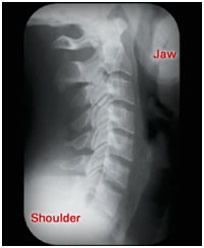 |
| Text Book Normal - This would be considered a textbook “normal” side view of the neck. |
Phase One
In Phase One there is a loss of curve and a reduced ability to turn and bend. In some cases, the disc space between adjacent vertebrae may be reduced. Or, discs can become wedge-shaped, inviting more serious soft tissue damage. Depending upon your body’s adaptive capacity, pain or other obvious symptoms may not be present. Even the resulting reduced range of motion may be too subtle for many to notice.
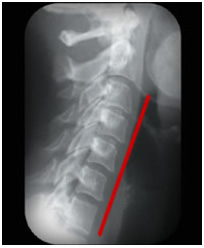 |
| Phase 1 Spinal Decay - The first thing you notice is a loss of the normal cervical curve. |
Phase Two
If neglected, in Phase Two, joint surfaces lose their clearly defined edges as the early signs of bone spurs become visible on X-ray views. Some believe that the body senses the accompanying inflammation as the sign of a broken bone. It begins the process of depositing calcium salts. Without being in a cast to prevent movement, fusion doesn’t occur.
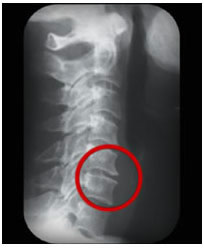 |
| Phase Two Spinal Decay -
Adjacent joint surfaces become rough and uneven. |
Phase Three
If still left uncorrected, the problem worsens in Phase Three. Amazingly, pain or other obvious symptoms may not yet show up. But finally, the body successfully “mends the broken bone.”
This process can take years. Its presence calls into question the claim that many patients make that they were “…fine until last week when I bent over to tie my shoes.” That’s not what the X-rays tell us!
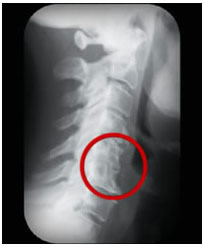 |
| Phase Three Spinal Decay -
The affected bones have lost their individuality and ability to move. |
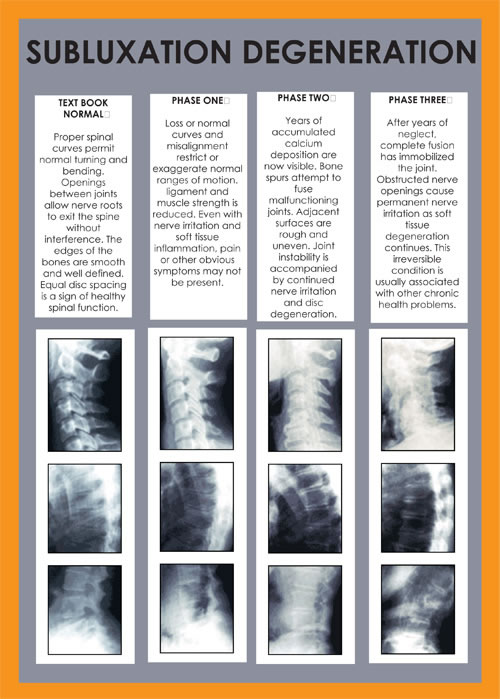
The Prognosis
Some patients who begin chiropractic care in Phase One discover a restoration of their spinal curves and improved range of motion. Success with Phase Two patients is less predictable and depends on many factors. While we can do little after decades of neglect with Phase Three cases, we instead turn our attention to those areas of the spine that have not yet been lost to the process. It’s impossible to predict what effect, if any, chiropractic care will have on slowing, stopping or reversing this process. Nor can a particular phase be used to predict how much care will be needed.
There is minimal blood supply to the disc, and blood is what brings healing nutrients and oxygen to damaged structures in the body. This means that the spinal disc lacks any significant reparative powers. Unlike muscles, which have good blood supply, once a spinal disc is injured it cannot repair itself.
^Back to Top
|




